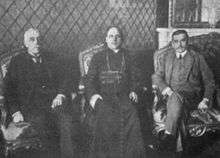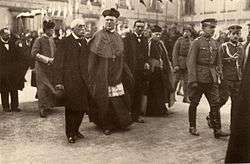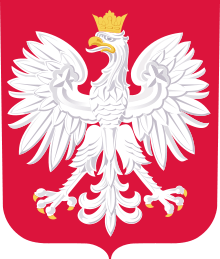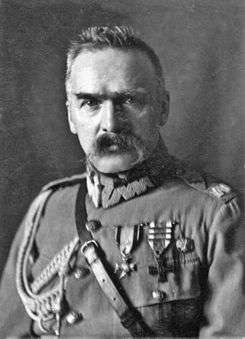Kingdom of Poland (1916–18)
| Kingdom of Poland | ||||||||||
| Königreich Polen (German) Królestwo Polskie (Polish) | ||||||||||
| Client / puppet state of the German Empire | ||||||||||
| ||||||||||
| ||||||||||
Occupation of the Kingdom of Poland during World War I. | ||||||||||
| Capital | Warsaw | |||||||||
| Languages | ||||||||||
| Government | Regency | |||||||||
| King | ||||||||||
| • | 1916–1918 | vacant | ||||||||
| Head of State | ||||||||||
| • | 14 Jan – 25 Aug 1917 | Council of Statea | ||||||||
| • | 1917–1918 | Regency Councila | ||||||||
| Prime Minister | ||||||||||
| • | Nov 1917 – Feb 1918 | Jan Kucharzewski | ||||||||
| • | 27 Feb – 4 Apr 1918 | Antoni Ponikowski | ||||||||
| • | 4 Apr – 23 Oct 1918 | Jan Kanty Steczkowski | ||||||||
| • | 23 Oct – 5 Nov 1918 | Józef Świeżyński | ||||||||
| • | 4–11 Nov 1918 | Władysław Wróblewski | ||||||||
| Historical era | World War I | |||||||||
| • | Act of 5th November | 5 November 1916 | ||||||||
| • | Treaty of Brest-Litovsk | 3 March 1918 | ||||||||
| • | Armistice | 11 November 1918 | ||||||||
| Currency | ||||||||||
| ||||||||||
| a. | Ruled as collective heads of state. | |||||||||
The Kingdom of Poland (Polish: Królestwo Polskie), also known informally as the Regency Kingdom of Poland (Polish: Królestwo Regencyjne), was a proposed puppet state of Germany during World War I.[1] In reality, the German Empire planners wanted to annex around 30,000 square kilometers of the territory of former Congress Poland and carry out ethnic cleansing up to 3 million Poles and Jews to make room for German colonists in the so-called Polish Border Strip plan.[2][3][4][5][6] The decision to promise restoration of Poland was taken by Germany in order to attempt to legitimize its military occupation amongst the Polish inhabitants, following upon German propaganda sent to the Poles in 1915 that German soldiers were arriving as liberators to free Poland from subjugation by Russia.[7] A draft of a constitution was proposed 1917.[8] German government used punitive threats to induce Polish landowners living in the German-occupied Baltic territories to move to the state and sell their Baltic property to Germans in exchange for moving to Poland, and efforts were made to remove Poles from Polish territories partitioned by Prussia.[9]
Following the armistice with Germany that ended World War I, the area became part of the Second Polish Republic.
Early plans
Germany
In 1914, for the purposes of securing Germany's eastern border against Russia, Theobald von Bethmann-Hollweg, the German chancellor, decided on the annexation of a strip of Polish land. In order to avoid adding the Polish population there to the German Empire, it was proposed that the population would be moved to a new Polish state further east, while the strip would be resettled with Germans.[10]
As World War I started, the German Emperor William II conceived of creating a dependent Polish state from territory conquered from Russia. This Polish kingdom, of limited autonomy, would be ruled by a German prince and have its military, transportation and economy controlled by Germany. Its army and railway network would be placed under Prussian command.
During the first year of the war, German and Austrian troops quickly conquered the Russian Vistula Land – the former Congress Poland – and, in 1915, divided its administration between a German Governor General in Warsaw and an Austrian counterpart in Lublin.
In several memoranda sent during 1915 and 1916, Hans Hartwig von Beseler, the Governor-General of the Polish areas under German control, proposed the establishment of an independent Polish state. Under the influence of General Erich Ludendorff, then in effect the director of Germany's eastern European operations, this proposal included the annexation of considerable amounts of land by Prussia, Lithuania and Austria-Hungary. Gerhard von Mutius, a cousin of Chancellor Bethmann-Hollweg and the foreign office's representative at Beseler's headquarters, disputed the use of annexation, insisting that "if the military interests allow for it, divisions and secessions should be avoided", as such a policy would secure an "anti-Russian inclination [toward] the new Poland".
Austria-Hungary
Austria-Hungary had three different ideas regarding Poland. One, the "Austro-Polish solution", involved the creation of a Polish kingdom under the Emperor of Austria, who, among his other titles, was already King of Galicia and Lodomeria. German and Magyar (Hungarian) elements within the Habsburg monarchy opposed such a move for fear of creating a predominantly Slavic area. Unlike Emperor Francis Joseph, however, Charles I of Austria, who had acceded to the Habsburg thrones in 1916, promoted the idea. The other two ideas involved the division of the former Congress Poland between Prussia and Austro-Hungary, or between Austro-Hungary and a state built from Lithuania, Belarus and the remnants of Congress Poland.[11]
The Austrians, however, had underestimated Germany's desire to determine Poland's fate.[12] They did recognise, according to Prime Minister Karl von Stürgkh, that "Poles will remain Poles [...] even 150 years after Galicia was joined to Austria, Poles still didn't become Austrians".[13] It was clear to Austrian politicians that the creation of a Polish state along the lines intended by Germany would mean the loss of Galicia, so they proposed its partition and the formation of East Galicia as an Austrian province.
Of the candidates for the new Polish throne, Archduke Charles Stephen of Austria (Polish: Karol Stefan) and his son Charles Albert were early contenders. Both resided in the Galician city of Saybusch (now Żywiec) and spoke Polish fluently. Charles Stephen's daughters were married to the Polish aristocrats Princes Czartoryski and Radziwiłł.
By early 1916, the "Austro-Polish solution" had become hypothetical. Erich von Falkenhayn, the German Chief of the General Staff had rejected the idea in January, followed by Bethmann-Hollweg in February. Bethmann-Hollweg had been willing to see an Austrian candidate on the new Polish throne, so long as Germany retained control over the Polish economy, resources and army[14] – in other words, so long as he became a virtual puppet ruler.
German candidates for the throne were disputed between the royal houses of Saxony, Württemberg and Bavaria.[15] Bavaria demanded that their Prince Leopold, the Supreme Commander of the German forces on the Eastern front, become the new monarch.[16] Württemberg's candidate Duke Albrecht was considered suitable for the throne because he belonged to the Catholic line of the house.[17] The Saxon House of Wettin's claim to the Polish throne was based on Frederick Augustus I of Saxony, who was made Duke of Warsaw by Napoleon during the Napoleonic Wars, and also to the election of Augustus II the Strong as the King of Poland and Grand Duke of Lithuania in 1697.[18]
German aims
During German occupation, Poles were subject to forced labour and confiscation of food and private property.[19]
Although early plans called for Austro-Polish solution, they were abandoned in February in face of growing dependence of Austria-Hungary on Germany[20] Both control over Polish economy and raw resources was to be in Germany's hands and Germany would also be in total control over the Polish army.
The borders of this "autonomous" Poland were to be changed in favour of Germany with annexation of the so-called "Polish Border Strip" which would lead to the annexation of considerable parts of Polish territory which had been part of the Russian partition of Poland. By the end of 1916 Germany wanted to annex almost 30,000 square kilometres of Polish territory. These lands were to be settled by ethnic Germans, while the Polish and Jewish population was to be removed.[21]
After the expected victory the Polish economy was to be dominated by Germany and preparations were made for German control over the Polish railway system, shipping in the Vistula and industrial areas in Dąbrowa basin, Radom and Kielce.[22]
Such plans were also proposed by members of German minority in Poland in the area of Łódź, who protested the Act of November 5, and in a letter to the German government demanded the annexation of western Poland by Germany and settlement of ethnic Germans in those areas.[23]
History
Proclamation promising creation of the state
After the German offensive failed in the Battle of Verdun and Austria suffered military setbacks against Italy, Generals Hindenburg and Ludendorff, now supreme commanders of the German military and increasingly the dominant force over the politics of both Germany and Austria, changed their positions on Poland: having previously considered Poland as a bargaining card in the event of a separate peace with Russia, they now postulated the establishment of a German dependency, hoping that the creation of a Polish army could replace the Central Powers' losses. In October 1916, at joint deliberations at Pszczyna, the German and Austrian leadership agreed to accelerate the proclamation promising creation of a Polish state in the future.

In the meantime, General von Beseler had managed to gain support among pro-Austrian Poles and the followers of Józef Piłsudski. The Narodowa Demokracja party (centred in Paris), however, rejected any cooperation with the Central Powers. After the German Emperor and Chancellor met with a Polish delegation led by Józef Brudziński, the final details were arranged. On November 5, 1916, Governor von Beseler at Warsaw issued an Act of November 5, in which he promised that a Polish state would be created, without specifying any future Polish ruler, Polish borders or system of governance and, for the first time since 1831, had the Royal Castle decorated with Polish flags. The Austrian Governor-General Kuk issued a similar proclamation at Lublin. A pro-German faction led by Władysław Studnicki existed but didn't gain any significant backing among Polish population.
Immediately after the proclamation, the German governor-general in Warsaw issued an advertisement for military recruitment, resulting in Polish protests which especially decried the absence of a Polish government.
Council of State
On 14 January 1917, a Provisional Council of State (Polish: Tymczasowa Rada Stanu) was established as a provisional government, consisting of fifteen members chosen by the German and ten by the Austrian authorities. The magnate Waclaw Niemojowski was appointed Crown Marshal, with Józef Mikułowski-Pomorski acting as his deputy. Franciszek Pius Radziwiłł and Józef Piłsudski were put in charge of the Military Commission. The Council's first proclamation espoused monarchical government, Poland's expansion towards the east and supported an army of volunteers. A National Council served as a provisional parliament. The Councillors insisted on actual Polish autonomy and, on 21 April, were given authority over education, law courts and propaganda. Still, students were dissatisfied with the extent of autonomy and organised a strike on 3 May, resulting in the temporary closing of all universities.
Meanwhile, U.S. President Woodrow Wilson's proclamation in favor of a unified and independent Poland (on 22 January 1917) and the downfall of the Tsar in the February Revolution strengthened the Polish forces favoring a neutral or pro-Entente stance.
Oath crisis
In December 1917, a brigade of Polish legions under Stanisław Szeptycki moved into Warsaw to form the officer corps of the new Polish army.
On 21 April, the Council of State had passed a proclamation in favor of the Polish army (German: Polnische Wehrmacht) and appointed Colonel Sikorski to oversee recruitment. The relationship between the Central Powers and the Polish legions became increasingly difficult, especially after the powers barred Austrian subjects from the Legions (now called the Polish auxiliary corps, Polski Korpus Posilkowy), aiming to divert them into the regular Austrian army. Piłsudski had abstained from the vote on the Polish army, and on 2 July resigned together with two left-wing State Councillors. The new army's oath drafted by the governors-general and passed by the Council of State resulted in a political crisis, especially since it was directed to an unspecified "future king" and emphasized the alliance with Germany and Austria. Several legionaries refused to take the oath and were arrested, prompting General von Beseler to arrest Piłsudski his associate Kazimierz Sosnkowski and have them confined in Germany. In August, the remains of the Legions, roughly ten thousand soldiers, were transferred to the Eastern front. Crown Marshall Niemojowski resigned on 6 August and the Council disbanded on 25 August.
"Regency" constitution

After the intermission of the Temporary Committee of the Provisional Council of State (Polish: Komisja Przejściowa Tymczasowej Rady Stanu), the Central Powers introduced a provisional constitution, the patent, on 12 September 1917. The patent devised a constitutional monarchy with a bicameral parliament but without ministerial responsibility. Only schools and courts were transferred to Polish authorities, but — under Polish protests — the German minority was given a separate school system. Pending the election of a King of Poland, a Regency Council (Polish: Rada Regencyjna) was installed as a provisional government. On 18 September, the following members of the Council were named:
- Aleksander Kakowski, Archbishop of Warsaw;
- the aristocrat Prince Zdzisław Lubomirski, who had served as mayor of Warsaw in 1916/17;
- and the bourgeois Józef Ostrowski, a great landowner and formerly the leading Polish politician in the Russian Duma.
The Regency Council was ceremonially installed on 15 October, the anniversary of Tadeusz Kościuszko's death, and on 26 November, appointed Jan Kucharzewski, a lawyer who had been working in the government since June, as Prime Minister.

Administration, however, strictly remained in the hands of German authorities, now headed by Otto von Steinmeister. In March 1918, a resolution of the German Reichstag called for the establishment of a native civil administration in Poland, Kurland and Lithuania. However, the German authorities refused to transfer administration to Polish authorities and merely considered Poles as candidates to be trained under German supervision.
After the oath crisis of 1917, recruitment to the Polish army had received scant support and achieved negligible results, reaching merely 5,000 men. In May 1918, the force was strengthened by General Józef Dowbór-Muśnicki moving his Polish corps — assembled from the former Tsarist army — to Poland. In August, the legionaries arrested for refusing the oath were released and some again volunteered for the Polish army.
In August 1918, Achille Ratti arrived in Warsaw as apostolic visitor to adjust the Catholic Church to the altered political circumstances. This appointment was mainly due to the influence of German Chancellor Georg von Hertling and Eugenio Pacelli, since 1917 Nuncio to Bavaria in Munich. Ratti gained fame in 1920 for being the only diplomat to stay in Warsaw during the Polish–Soviet War and was elected as Pope Pius XI in 1922.
End of the German plans
After Germany's 1918 Spring Offensive had failed to win the war on the Western front, General Ludendorff in September proposed seeking peace based on the plan outlined by U.S. President Wilson in January 1918 in his Fourteen Points, which in regard to Poland demanded the creation of an "independent Polish state ... guaranteed by international covenant" with "free and secure access to the sea". On 3 October the new German Chancellor, Prince Max of Baden, announced Germany's acceptance of Wilson's plan and an immediate disestablishment of military administration in the countries occupied by Germany. Three days later the Regency Council in Warsaw also adopted Wilson's proposals as the basis for creating a Polish state.
On 1 October, General von Beseler had conferred with Hindenburg at Berlin and, informed of the gloomy military situation, had returned to Warsaw ill and dispirited. On 6 October, he handed over administration to Polish civil servants and, on 23 October, transferred the command over Polish forces (which by then included the Polish regiments of the Austro-Hungarian Army) to the Regency Council.
However, another Polish government based in Lublin arose to challenge the Regency's authority: on 6 November Ignacy Daszyński proclaimed the "Polish People's Republic" (Tymczasowy Rząd Ludowy Republiki Polskiej - literally: "Temporary People's Council of the Polish Republic"), with Daszyński himself (a Socialist politician and formerly a member of the Austrian parliament) as Prime Minister and Colonel Edward Rydz-Śmigły as military commander. Moderates in Warsaw, who now hoped for a return of General Piłsudski, who was still held in custody at Magdeburg, repudiated Lublin's declaration of the deposition of the Regency to be deposed and its plans for radical social reforms. Already in October the Regency Council had requested Piłsudski's release, and after negotiations through Harry Graf Kessler the General was allowed to return to Warsaw, where he arrived on 10 November. The following day Germany signed the armistice and German troops in Warsaw were disarmed as they refused to fire on Polish insurgents. Both the Regency Council and the Daszyński government ceded all authority to Piłsudski. The Regency dissolved itself three days later.
Supreme officeholders
Occupation authorities
German Governor-General at Warsaw, commander-in-chief of the Polska Siła Zbrojna — Hans Hartwig von Beseler (1 October 1915 – 11 November 1918)
Austro-Hungarian Governors-General at Lublin:
- Major General Erich Freiherr von Diller (1 October 1915 – 20 April 1916)
- Feldzeugmeister Karl Kuk (21 April 1916 – April 1917)
- Major General Stanislaus Graf Szeptycki (April 1917 – 28 February 1918)
- Infantry General Anton Lipoščak (1 March – 11 November 1918)
State authorities
- Provisional Council of State (14 January – 15 August 1917) — Waclaw Niemojowski, Crown Marshall (14 January – 6 August 1917), Józef Mikułowski-Pomorski, Deputy Marshall
- Regency Council (15 October 1917 – 14 November 1918) — archbishop Aleksander Kakowski, prince Zdzisław Lubomirski, Józef Ostrowski
Borders
In their proclamation of 5 November 1916, the Central Powers refused to determine the Polish borders.
Eastern
Following the Bolsheviks taking power in Russia in November 1917, some Polish politicians sided with Germany as the "last bulwark of order" against the Bolshevik threat but Germany's policy of creating several smaller client states east of Poland, supported especially by the supreme command under Ludendorff, also heightened resistance to German presence in Polish territories.
With the support of the German military, the Council of Lithuania proclaimed an independent Lithuanian state on 11 December. Polish sentiment reacted strongly, as it considered Poland and Lithuania to be a historical union and especially since it regarded Wilna (Vilnius), the proposed new Lithuanian capital as a Polish city.
The Regency Council sought admission to the negotiations with the Bolshevik government during travels to Berlin and Vienna early in 1918 but only gained German Chancellor Georg von Hertling's promise to admit the Polish government in an advisory capacity. This, however, was refused by the Bolshevik representatives, who denied the Polish government any legitimacy. The German representative Max Hoffmann expressed a belief that "independent Poland was always considered by me to be a utopia, and I have no doubts regarding my support for Ukrainian claims."[24] When the Treaty of Brest-Litovsk, signed on 9 February, ceded the province of Chełm — which had been part of Congress Poland until 1913 — to the new state of Ukraine, many in Poland regarded this as a "Fourth partition of Poland", prompting a "political general strike" in Warsaw on 14 February and the resignation of the Jan Kucharzewski administration later that month. Parts of the Polish auxiliary corps under Józef Haller protested by breaking through the Austro-Russian front line to Ukraine, where they united with Polish detachments which had left the Tsarist army. After a fierce battle with the German army at Kaniów in May, the remnants were interned, though Haller managed to escape to Moscow.
Western
However, Poland's unspecified borders were threatened in the West as well: Late in 1917, the German supreme command had proposed annexing a "border strip" to Germany,[21] a policy earlier suggested by a letter to the German government by members of Poland's German minority, settled around Łódź. Such plans were agreed to in principle by the German government in March 1918 and in April gained support in the Prussian House of Lords but were strongly opposed by General von Beseler in a report to Emperor William.
In July, Ludendorff specified his plans in a memorandum, proposing annexing a greatly enlarged "border strip" of 20,000 square kilometers.[20][21] In August, Emperor Charles of Austria insisted on the Austro-Polish option, forbidding Archduke Charles Stephen from accepting the crown and declaring his opposition to any German plans for annexation. In response, General Ludendorff agreed to leave Wilno (and possibly Minsk) to Poland but reaffirmed the "border strip" plan. However, this did little to soothe Polish sentiment, which regarded the return of Wilno as self-evident and refused to yield any part of the former Kingdom of Poland.
See also
Notes
- ↑ The Regency Kingdom has been referred to as a puppet state by Norman Davies in Europe: A history (Google Books, p. 910); by Jerzy Lukowski and Hubert Zawadzki in A Concise History of Poland (Google Books, p. 218); by Piotr J. Wroblel in Chronology of Polish History and Nation and History (Google Books, p. 454); and by Raymond Leslie Buell in Poland: Key to Europe (Google Books, p. 68: "The Polish Kingdom... was merely a pawn [of Germany]").
- ↑ Immanuel Geiss Tzw. polski pas graniczny 1914-1918. Warszawa (1964).
- ↑ Elusive Alliance: The German Occupation of Poland in World War I Jesse Kauffman - 2015
- ↑ Military Occupations in First World War Europe Sophie De Schaepdrijver page 69, Routledge, 2015
- ↑ The Great and Holy War: How World War I Changed Religion For Ever Philip Jenkins, page 38, Lion, 2014
- ↑ A State of Nations: Empire and Nation-Making in the Age of Lenin and Stalin Autorzy Ronald Grigor Suny,Terry Martin, page 126, Oxford University Press 2001 "To wall off this space, German planners discussed establishing an ethnically cleansed border strip in Poland, cleared of all Slavs and settled by ethnic Germans. Ober Ost officials deported large segments of the local population"
- ↑ Aviel Roshwald. Ethnic Nationalism and the Fall of Empires: Central Europe, the Middle East and Russia, 1914-23. Routledge, 2002. P. 117.
- ↑ J. M. Roberts. Europe 1880-1945. P. 232.
- ↑ Annemarie Sammartino. The Impossible Border: Germany and the East, 1914-1922. Cornell University, 2010. P. 36-37.
- ↑ Holborn 1982, p. 449 (see "Sources" section below).
- ↑ Pajewski 2005, p. 91.
- ↑ Pajewski 2005, pp. 92–93.
- ↑ Pajewski 2005, p. 93.
- ↑ Hein Eirch Goemans 2000, p. 104 (see "Sources" section below).
- ↑ Tipton, Frank B. A History of Modern Germany Since 1815, p. 312, ISBN 0520240499
- ↑ Polskie Towarzystwo Historyczne (Polish Historical Society), Przegląd historyczny (Historical Review), volume 60, page 87.
- ↑ Tucker, Spencer C. The European Powers in the First World War: An Encyclopedia, p. 34, ISBN 1135507015
- ↑ Craig, Gordon A. Germany: 1866–1945, p. 358-359, ISBN 0192851012
- ↑ Primary Documents: Speech by Polish Member of Prussian Legislature Regarding German Rule in Poland, 1917; Source: Source Records of the Great War, Vol. IV, ed. Charles F. Horne, National Alumni 1923
- 1 2 Hein Erich Goemans, War and Punishment: The Causes of War Termination and the First World War, Princeton University Press, 2000, ISBN 0-691-04944-0, pp. 104–105
- 1 2 3 Keith Bullivant, Geoffrey J. Giles and Walter Pape, Germany and Eastern Europe: Cultural Identity and Cultural Differences, Rodopi, 1999, ISBN 90-420-0678-1, p. 28-9
- ↑ Prete, Roy Arnold; Ion, A. Hamish (1984). Armies of occupation. Wilfrid Laurier University Press. p. 128. ISBN 0-88920-156-0.
- ↑ Aleksander Kraushar, Warszawa podczas okupacji niemieckiej 1915–1918, Lwów 1921, p. 39
- ↑ Pajewski 643
Sources
- (Polish) Immanuel Geiss, Tzw., Polski Pas Graniczny 1914-1918, Warszawa, 1964.
- (Polish) Janusz Pajewski, Pierwsza Wojna Światowa 1914-1918, Wydawnictwa PWN, 2005.
- (Polish) Piotr Eberhardt, "Projekty aneksyjne Cesarstwa Niemieckiego wobec ziem polskich podczas I wojny swiatowej in Problematyka geopolityczna ziem polskich", Warszawa: PAN IGiPZ, 2008.
- Hajo Holborn, A History of Modern Germany: 1840-1945, Princeton University Press, 1982.
- Hein Eirch Goemans, War and punishment: the causes of war termination and the First World War, Princeton University Press, 2000.
- (Polish) Pro memoria. Prusak w Polsce, by Józef Rapacki, Wydawnictwo Tygodnika Ilustrowanego, Warszawa.

.svg.png)


